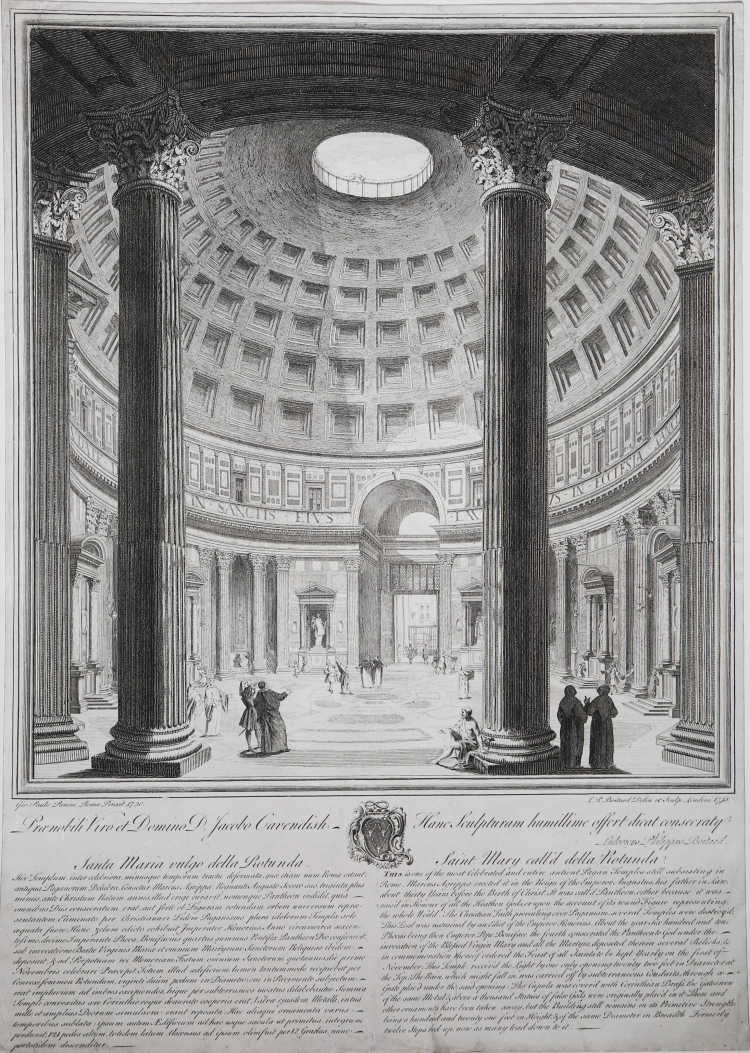




| Reference: | S45611 |
| Author | Louis Philippe BOITARD |
| Year: | 1738 |
| Zone: | Pantheon |
| Printed: | London |
| Measures: | 415 x 585 mm |



| Reference: | S45611 |
| Author | Louis Philippe BOITARD |
| Year: | 1738 |
| Zone: | Pantheon |
| Printed: | London |
| Measures: | 415 x 585 mm |
The interior of the Pantheon, or Santa Maria della Rotunda, drawn and etched by Boitard after a painting by Giovanni Paolo Panini, is depicted with daylight streaming through the oculus in the ceiling. The view is between two columns, looking north from the main altar towards the entrance and the Piazza della Rotonda. A number of figures converse, while others admire the architecture or regard the two figures leaning over the edge of the oculus' opening. Inscription with the building's history in two columns, with Latin on the left and English on the right.
Etching, 1738, lettered below the image in English and Italian with the title, a description, a dedication from the engraver, in Latin, to James Cavendish, around a crest and 'Gio. Paolo Panini Roma Pinxit 1730. / L.P. Boitard Delin et Sculp. Londini 1738.
Giovanni Paolo Pannini (or Panini; Piacenza, 1691 - Rome, 1765) was an Italian painter, architect and stage designer. As a young man Panini studied in Piacenza as a theater set designer. He went to Rome in 1711 where he studied drawing with Benedetto Luti and became famous as a decorator of palaces, including Villa Patrizi (1718-1725) and Palazzo de Carolis (1720). As a painter, Panini is best known for his views of Rome; he was particularly interested in the city's antiquities and became one of the great masters of the Grand Tour. Among his most famous works is the interior of the Pantheon and his "vedute," paintings of picture galleries that in turn contain views of Rome. In 1718 Panini was admitted to the Congregation of the Virtuosi at the Pantheon. He taught in Rome at the Academy of St. Luke from 1719 and at the Académie de France from 1732; his students included Hubert Robert and Jean-Honoré Fragonard.
Louis Philippe Boitard, sometimes incorrectly called Louis Pierre Boitard. Draughtsman and engraver; son of François Boitard (1667-1719), born in France; based in London 1709 to 1712 and with whom he probably trained; during 1740s he worked as a journeyman in the studio of the engraver, William Henry Toms, alongside the young John Boydell who recorded that he was addicted to snuff, always indigent and drowned in the New River.
Etching, printed on contemporary laid paper, trimmed to the platemark, in good condition.
A fine example of this very rare work.
|
Louis Philippe Boitard, sometimes incorrectly called Louis Pierre Boitard. Draughtsman and engraver; son of François Boitard (1667-1719), born in France; based in London 1709 to 1712 and with whom he probably trained; during 1740s he worked as a journeyman in the studio of the engraver, William Henry Toms, alongside the young John Boydell who recorded that he was addicted to snuff, always indigent and drowned in the New River.
|
|
Louis Philippe Boitard, sometimes incorrectly called Louis Pierre Boitard. Draughtsman and engraver; son of François Boitard (1667-1719), born in France; based in London 1709 to 1712 and with whom he probably trained; during 1740s he worked as a journeyman in the studio of the engraver, William Henry Toms, alongside the young John Boydell who recorded that he was addicted to snuff, always indigent and drowned in the New River.
|